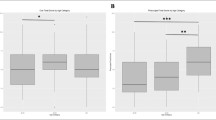Abstract
Older adults may evidence changes in swallowing physiology. Our goals were to identify dysphagia risk in community-dwelling older adults with no history of dysphagia, and to compare swallowing physiology and safety between older and younger adults. Thirty-two older adults with no history of dysphagia were prospectively recruited and completed the Dysphagia Handicap Index (DHI), two trials of a 3 oz. swallow screen, and videofluoroscopy (VFSS). Self-ratings of swallowing function were compared to published norms by paired t tests, and multivariate logistic regression models were generated to determine whether these ratings and VFSS analysis of swallowing function were associated with failure of one or both swallow screen trials. Archived VFSS of 33 younger adults were compared to older adults with Wilcoxon rank-sum tests. The DHI scores of older adults were higher than published non-dysphagic adults but lower than dysphagic adults. Older participants with greater Oral Residue scores were more likely to fail both swallow screen trials. Older adults received higher median MBSImP™© scores for select pharyngeal components than younger adults. The two age groups did not differ on Penetration-Aspiration Scale scores, and no aspiration was observed. Measures of swallowing in older individuals may reflect age-related sensory and motor changes in the context of functional swallowing and adequate airway protection.
Similar content being viewed by others
References
Baijens LW, Clavé P, Cras P, Ekberg O, Forster A, Kolb GF, Leners J, Masiero S, Mateos-Nozal J, Ortega O. European Society for Swallowing Disorders-European Union Geriatric Medicine Society white paper: oropharyngeal dysphagia as a geriatric syndrome. Clin Interv Aging. 2016;11:1403.
Chen P, Golub JS, Hapner ER, Johns MM. Prevalence of perceived dysphagia and quality-of-life impairment in a geriatric population. Dysphagia. 2009;24:1–6.
Holland G, Jayasekeran V, Pendleton N, Horan M, Jones M, Hamdy S. Prevalence and symptom profiling of oropharyngeal dysphagia in a community dwelling of an elderly population: a self-reporting questionnaire survey. Dis Esophagus. 2011;24:476–80.
Yang EJ, Kim MH, Lim J, Paik N. Oropharyngeal dysphagia in a community-based elderly cohort: the Korean longitudinal study on health and aging. J Korean Med Sci. 2013;28:1534–9.
Ekberg O, Feinberg MJ. Altered swallowing function in elderly patients without dysphagia: radiologic findings in 56 cases. AJR Am J Roentgenol. 1991;156:1181–4.
Robbins J, Hamilton JW, Lof GL, Kempster GB. Oropharyngeal swallowing in normal adults of different ages. Gastroenterology. 1992;103:823–9.
Yoshikawa M, Yoshida M, Nagasaki T, Tanimoto K, Tsuga K, Akagawa Y, Komatsu T. Aspects of swallowing in healthy dentate elderly persons older than 80 years. J Gerontol Ser A. 2005;60:506–9.
Steele CM, Van Lieshout P. Tongue movements during water swallowing in healthy young and older adults. J Speech Lang Hear Res. 2009;52:1255–67.
Omari T, Kritas S, Cock C, Besanko L, Burgstad C, Thompson A, Rommel N, Heddle R, Fraser R. Swallowing dysfunction in healthy older people using pharyngeal pressure-flow analysis. Neurogastroenterol Motil. 2014;26:59–68.
Martin R, Barr A, MacIntosh B, Smith R, Stevens T, Taves D, Gati J, Menon R, Hachinski V. Cerebral cortical processing of swallowing in older adults. Exp Brain Res. 2007;176:12–22.
Centers for Disease Control and Prevention (CDC). Prevalence of stroke–United States, 2005. MMWR Morb Mortal Wkly Rep. 2007;56:469–74.
Aronson MK, Ooi WL, Geva DL, Masur D, Blau A, Frishman W. Dementia: age-dependent incidence, prevalence, and mortality in the old old. Arch Intern Med. 1991;151:989–92.
González-Fernández M, Humbert I, Winegrad H, Cappola AR, Fried LP. Dysphagia in old-old women: prevalence as determined according to self-report and the 3-ounce water swallowing test. J Am Geriatr Soc. 2014;62:716–20.
Silbergleit AK, Schultz L, Jacobson BH, Beardsley T, Johnson AF. The dysphagia handicap index: development and validation. Dysphagia. 2012;27:46–52.
DePippo KL, Holas MA, Reding MJ. Validation of the 3-oz water swallow test for aspiration following stroke. Arch Neurol. 1992;49:1259–61.
Suiter DM, Leder SB. Clinical utility of the 3-ounce water swallow test. Dysphagia. 2008;23:244–50.
Martin-Harris B, Brodsky MB, Michel Y, Castell DO, Schleicher M, Sandidge J, Maxwell R, Blair J. MBS measurement tool for swallow impairment–MBSImp: establishing a standard. Dysphagia. 2008;23:392–405.
Rosenbek JC, Robbins JA, Roecker EB, Coyle JL, Wood JL. A penetration-aspiration scale. Dysphagia. 1996;11:93–8.
Bursac Z, Gauss CH, Williams DK, Hosmer DW. Purposeful selection of variables in logistic regression. Source Code Biol Med. 2008;3:17.
Maeda K, Akagi J. Sarcopenia is an independent risk factor of dysphagia in hospitalized older people. Geriatr Gerontol Int. 2016;16:515–21.
Baum B, Bodner L. Aging and oral motor function: evidence for altered performance among older persons. J Dent Res. 1983;62:2–6.
Hiramatsu T, Kataoka H, Osaki M, Hagino H. Effect of aging on oral and swallowing function after meal consumption. Clin Interv Aging. 2015;10:229–35.
Martin JH, Diamond B, Aviv JE, Jones ME, Keen MS, Wee TA, Blitzer A. Age-related changes in pharyngeal and supraglottic sensation. Ann Otol Rhinol Laryngol. 1994;103:749–52.
Landt H, Fransson B. Oral ability to recognize forms and oral muscular coordination ability in dentulous young and elderly adults. J Oral Rehabil. 1975;2:125–38.
Nagy A, Leigh C, Hori SF, Molfenter SM, Shariff T, Steele CM. Timing differences between cued and noncued swallows in healthy young adults. Dysphagia. 2013;28:428–34.
Fink TA, Ross JB. Are we testing a true thin liquid? Dysphagia. 2009;24:285–9.
Acknowledgements
The research reported in this paper was supported by the National Institutes of Health through Awards K23DC011056 (National Institute on Deafness and Other Communication Disorders) and T32HD007414 (National Center for Medical Rehabilitation Research). The content is solely the responsibility of the authors and does not necessarily represent the views of the National Institutes of Health.
Author information
Authors and Affiliations
Corresponding author
Rights and permissions
About this article
Cite this article
Mulheren, R.W., Azola, A.M., Kwiatkowski, S. et al. Swallowing Changes in Community-Dwelling Older Adults. Dysphagia 33, 848–856 (2018). https://doi.org/10.1007/s00455-018-9911-x
Received:
Accepted:
Published:
Issue Date:
DOI: https://doi.org/10.1007/s00455-018-9911-x



